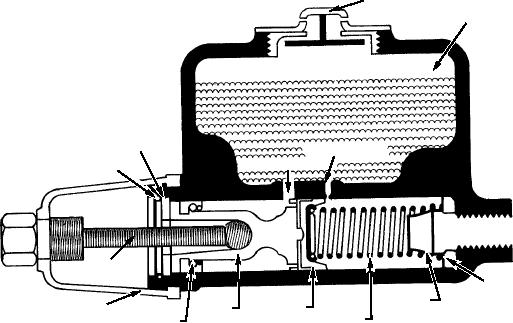
T h e r e s e r vo i r i s s e a l e d a t t h e t o p w i t h a
This pressure overcomes the tension of the retracting
combination filler and breather cap, which permits
springs and forces the shoes against the drums. As the
atmospheric pressure on the fluid at all times.
pressure on the foot pedal is increased, greater pressure
is built up within the wheel cylinders and,
The piston is a spool-like member with a rubber or
consequently, greater force is exerted against the
leather cup seal at either end. These seals are referred
shoes.
to as the primary and secondary cups. The primary cup
is held against the piston by the return spring and acts
When the pressure on the pedal is released, the
against the brake fluid during the braking stroke. The
brake shoe retracting springs return the brake shoes to
secondary cup is located at the other end of the piston
their normal or released position. The return
and prevents external leakage of the brake fluid.
movement of the brake shoes, in turn, causes
An explanation of the two-way valve can be made
movement of the wheel cylinder pistons toward their
with reference to figure 2-38. As pressure is applied to
released position since the force from the master
the foot pedal and the piston is forced into the cylinder,
cylinder is removed. The displaced fluid returns to the
the fluid pressure is applied to the inner and outer
reservoir.
segments of the two-way valve. The spring, acting
Master Cylinder.--A cutaway view of a typical
against the inner segment, is comparatively light. As
master cylinder is shown in figure 2-37. The unit
the fluid pressure opens this valve, additional fluid
consists basically of an iron casting that contains a
enters the hydraulic lines, applying pressure to the
reservoir for the fluid and a machine-finished precision
pistons in the wheel cylinders.
cylinder that houses the piston, return spring, and
As the brake pedal is released, fluid pressure in the
two-way valve assembly.
wheel cylinders decreases. The brake shoe retracting
There are two ports leading from the reservoir
springs, acting against the wheel cylinder pistons,
(supply tank) to the cylinder--the breather port and the
cause a slight back pressure in the fluid lines. This
pressure overcomes the tension of the return spring and
compensating port. Both ports serve to furnish fluid to
forces the entire two-way valve assembly off its seat.
the cylinder for the braking stroke. In addition, the
This allows some of the fluid from the lines to enter the
breather port allows the fluid on the rod side of the
reservoir.
piston to escape to the reservoir during the release
stroke. This prevents a fluid lock when the brakes are
When the pressure in the lines decreases to
released. The compensating port allows fluid to flow to
approximately 6 to 16 psi, the return spring closes the
and from the reservoir to allow for thermal expansion
valve unit against its seat. As a result the system
and contraction. Thus, a constant volume is maintained
remains under a small pressure. This pressure does not
in the system at all times.
cause the shoes to drag, but it does assure a positive
FILLER CAP
SUPPLY TANK
COMPENSATING
PISTON STOP
PORT
BREATHER PORT
RETAINER SPRING
LINK
VALVE SEAT
CHECK
PRIMARY
VALVE
BOOT
CUP
PISTON
RETURN
ASf02037
SPRING
SECONDARY CUP
Figure 2-37.--Hydraulic brake master cylinder.
2-29

